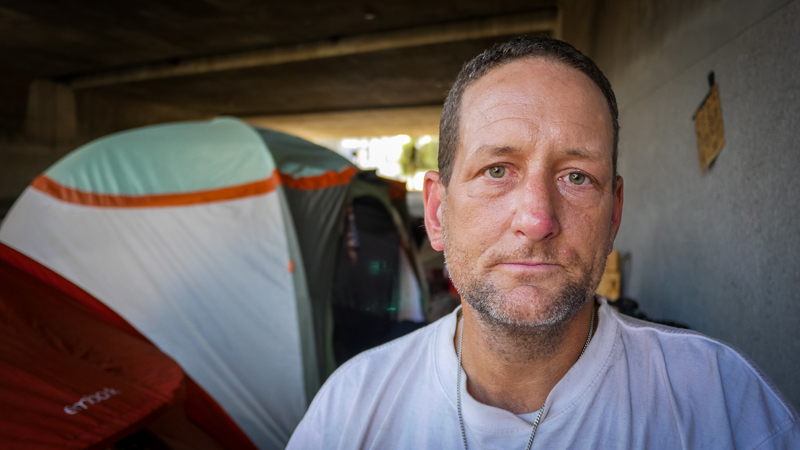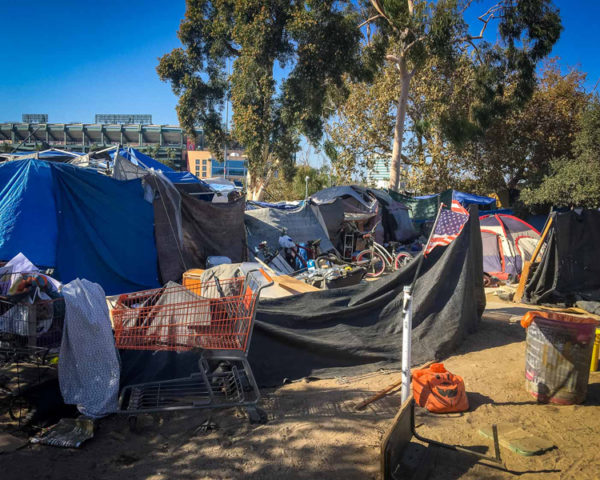Tent Cities in Seattle and California
Tent cities are places where people live together in a group of makeshift tents and tarps and other shelters. Wooded areas, public parks, vacant lots, under highway overpasses, in church parking lots, are some popular places for tent cities.
The structures people live in may not be physically sound or structurally safe. Many do not have running water, electrical hook-ups, cooking facilities, showers, toilets, or access to sewage disposal and other sanitary services. Yet, residents in many—but not all—encampments have a greater sense of community and security than when living on the street or spending the night in a shelter. Some tent cities create their own rules and set up patrols to keep residents safe.
Local governments and neighbors have varying reactions to tent encampments. Many municipal governments do not support encampments on public property. Instead, they conduct sweeps and raids that force people to move elsewhere. Sometimes people must leave precious belongings behind or face arrest.
According to the National Homelessness Law Center:
- 97 percent of cities do not require that alternative housing be provided
- 89 percent do not require storage of personal property or any period of notice when clearing encampments.
That said, some local governments support tent cities and their residents.
Sanctioned Tent Cities
Seattle, WA is one of the first major U.S. cities to accept encampments. This helps provide safer living conditions for people living in tents, cars, and on the streets. Seattle has nine city-permitted villages operated by contract with the Low Income Housing Institute. Each night, they provide more than 300 people a tiny house structure that locks. They also offer access to restrooms and showers, case management, a kitchen and a managed community.
In many of the villages, residents create community norms and codes of conduct. Seattle also has specific rules for dealing with unauthorized encampments. This includes how and when encampments will be removed as well as notice of the removal, where to find alternate shelter options, and how to retrieve personal belongings. More cities are sanctioning tent cities as a way to help homeless people receive care in a socially-distanced manner during the coronavirus pandemic.
Temporary Dwellings
In California, rents, evictions, and homelessness have increased significantly in recent years. A growing number of tent cities have emerged in places like streets, city centers and business districts. Tent cities have also surfaced along the hillsides in Sacramento, San Francisco, San Diego, and Los Angeles. Authorities cleared out an encampment along the Santa Ana River in Orange County displacing more than 700 people in the spring of 2018. Several other encampments (some that have existed for years) were cleared out in San Francisco and other places in CA during the first half of 2018 for public safety and health concerns.
In an effort to provide sanctioned shelter, San Diego officials partnered with business leaders to erect three temporary structures. These large industrial size tents sleep almost 700 people in bunk beds. Officials give people with mental or physical disabilities who qualify for housing subsidies priority. Everyone is paired with a housing navigator and has access to services such as healthcare and employment assistance. Showers and laundry facilities are also available.
The COVID-19 pandemic has caused some cities to sanction temporary tent cities. These have marked spaces for tents, showers, laundromats, toilets, meals and access to medical care. Despite CDC recommendations that tent encampments should remain if there are no other housing options, sweeps continue, like the one at Echo Park Lake in March of 2021.
Are tent cities a short or long term solution to homelessness? Read more.












